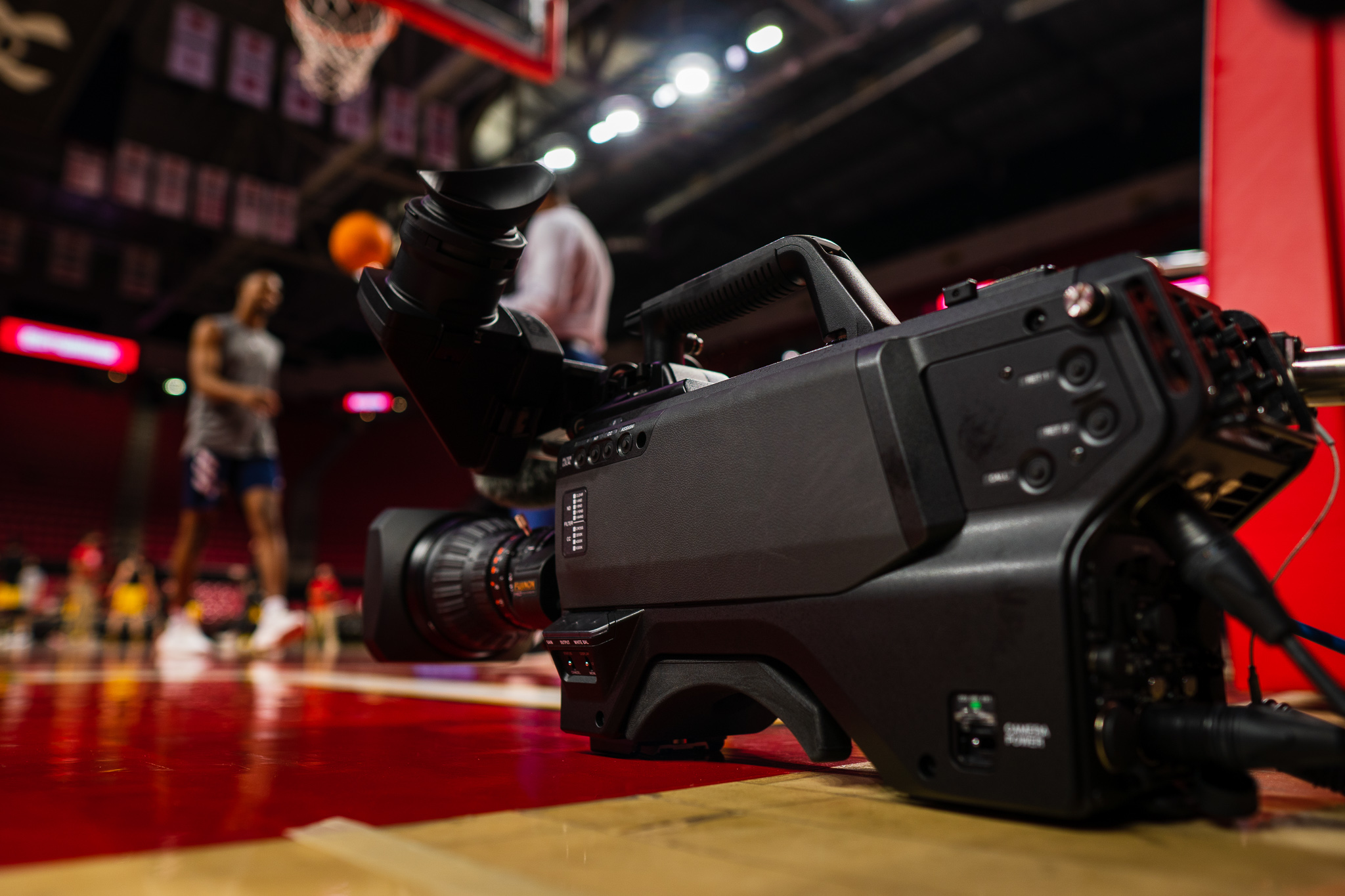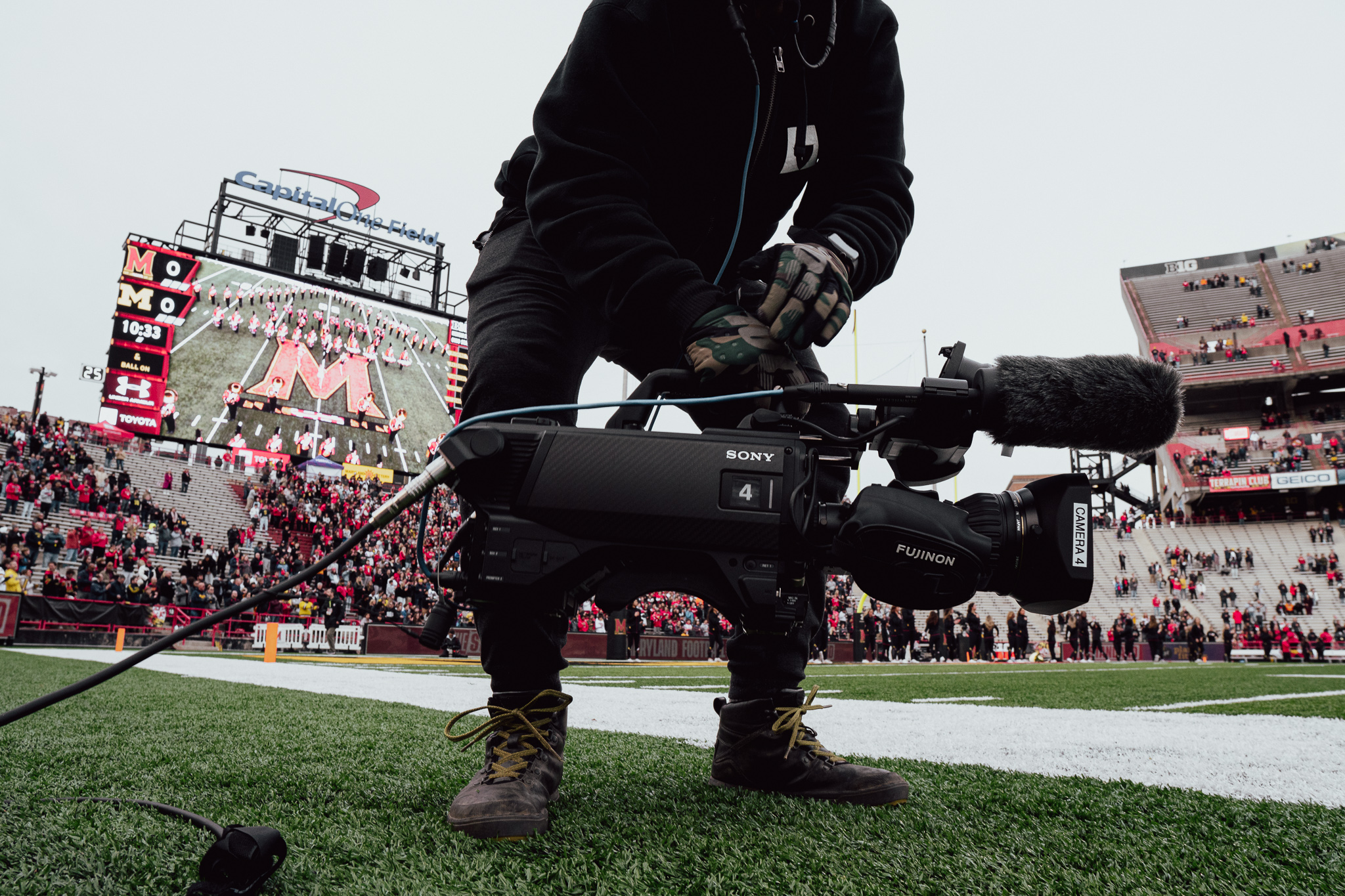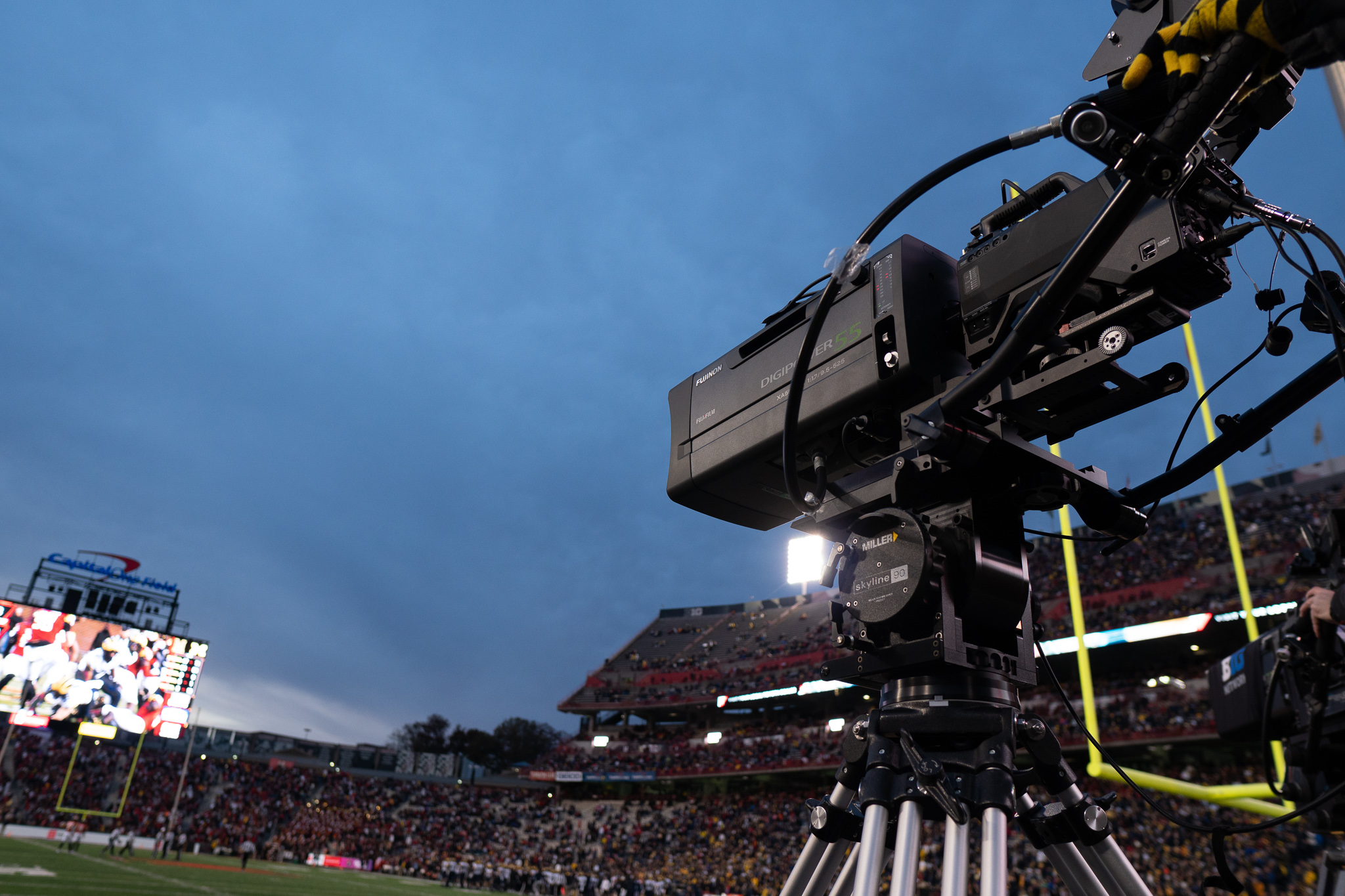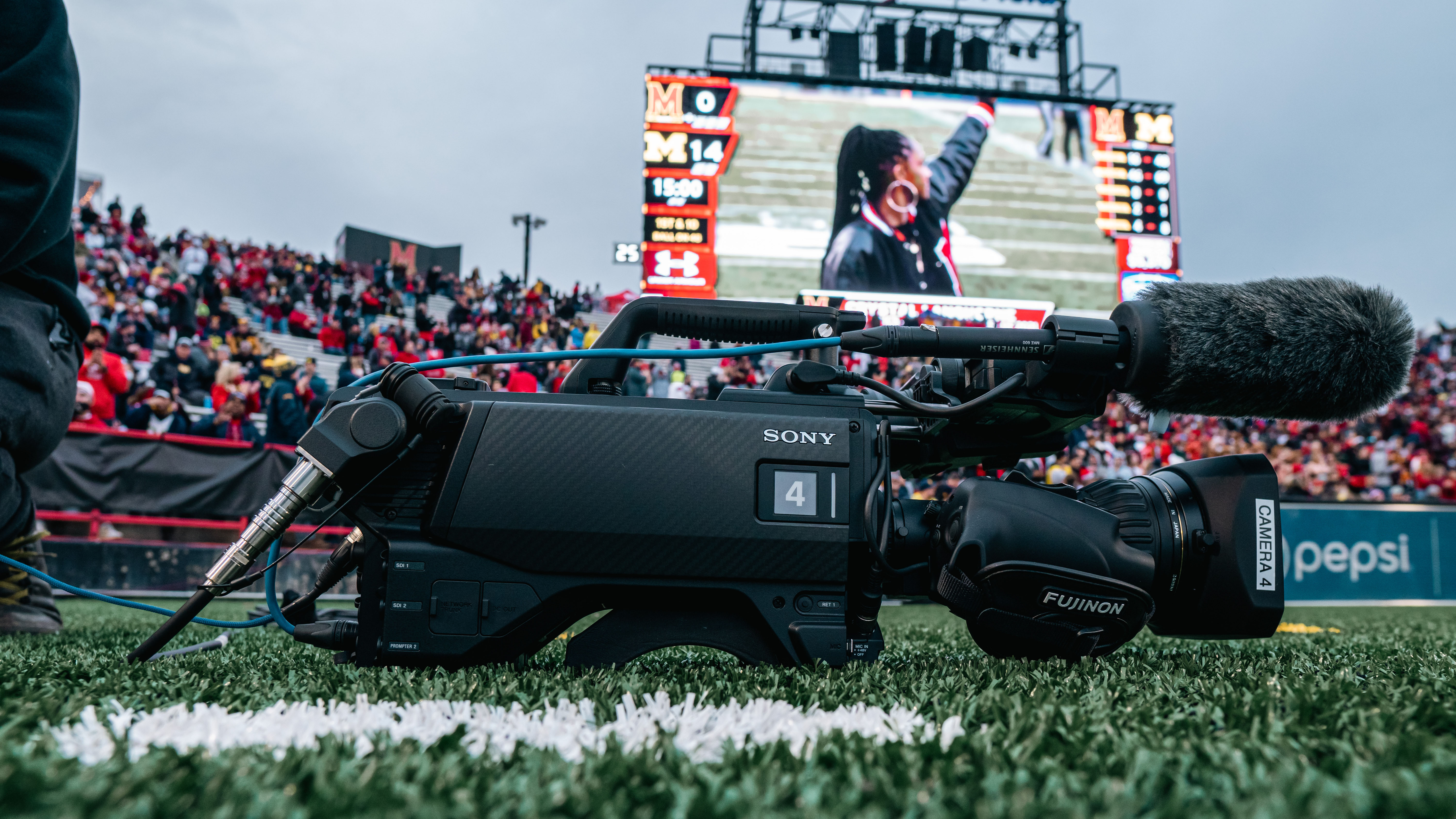University of Maryland’s Athletics Department recently refreshed its facilities implementing the latest high-end technology across the school’s venues to heighten engagement for viewers in-person and at home. Among those state-of-the-art advancements were upgraded cameras. The university, a legacy Sony customer, tested many competitive cameras and ultimately standardized on eight of Sony’s dependable HFR-capable HDC-3500 system cameras and two BRC-X1000 pan-tilt-zoom (PTZ) cameras.
Josh Clayton is the assistant athletics director of TerpVision and video operations for Maryland, overseeing and managing the imagery on the boards in the school’s venues while supporting broadcast and production efforts across a majority of their sports offerings. This includes work with the Big 10 Network, streaming and outside television broadcasts. In addition, he serves as the game day producer for the school’s video board shows at their football stadium and basketball arena, and prides himself on creating a unique and memorable experience that brings fans from their homes into the university’s venues.
[Sony Designates Charter Members of Professional AV Alliance Partner Network]
With “unwavering” support from the school’s athletics department, Clayton was instrumental in the camera selection for the upgrade, as he sought to address the increasing demand for content. While the school still uses some of their previous Sony imaging technology, as more shows were being requested, the need to simultaneously capture different sports grew. This necessitated more cameras for the TerpVision team, allowing them to be in more places. As he looked to the future, Clayton said he wanted to allow his team to “put their best foot forward” and “boldly lead the charge” in bringing HDR to college sports and the Big 10.

Maryland conducted a blind shootout pitting Sony’s cameras against the competition. As Clayton describes it, the decision was a no-brainer. “After reviewing the cameras, it was clear there was one option that was head and shoulders above the rest, and that was the Sony HDC-3500. Paired with our comfortability with Sony cameras and their layout, it was an easy decision and an easy transition for us to make.
“The legacy and security of the Sony name helped drive our decision. Sony’s support team always goes above and beyond, which takes a lot of the worry away. Sony helps position us to be the best and get the most out of our technology.
[SCN Top 50 Systems Integrators 2021]
“Another important element was the image matching and ecosystem compatibility between our older triax cameras and these new HDC-3500s," Clayton continued. "The first time we fired up the cameras without really painting, everything looked amazing. And that’s just what we wanted—to have everything work right out of the box and not have to worry about the details.”

With a new 3600 x 1620 video board and updated camera technology, Clayton knew he could make the university’s dream a reality and take their productions to the next level.
“With the HDC-3500s, there’s more paint on the brush, and we can really accurately use that brush now. These cameras allowed us to cast our net as wide as possible since we cover so many different sports," Clayton shared. “We wanted to pave the way for HDR in college sports. We learned from the trials, tribulations and successes of other industry leaders and outlined what we felt would work for us. We’ve certainly learned a lot along the way. I like to use the phrase: we’re flying the airplane as we build it…and we’re also writing the instruction manual.”
In addition to HDR, Maryland is also invested in another beneficial trend in capture: high frame rate (HFR). Clayton’s team has two HFR licenses to enable 4X super slo-mo for the HDC-3500s, which he uses frequently for gymnastics, volleyball, baseball and football, among others. “Being able to have expanded replay with TDs has been valuable," he said.
[Major League AV at Toronto's Rogers Centre]
Maryland is also using Sony’s BRC-X1000 pan-tilt-zoom robotic cameras, which offer the resolution and color-matching to easily integrate with the rest of the school’s camera footage.
Long on Clayton’s wish-list had been a center-hung camera. When introduced to the BRC-X1000, he knew it would be the ideal solution. He explained, “I’d been trying to push for a robocam in the center-hung, above the basketball court, for years. When I saw the X1000, I thought it was the perfect camera for us to put under the video board at the XFINITY.”
“When the players are walking to the court for tip-off, the camera operator swings the camera down and starts to push in on the referee’s hand as he gets ready to throw the ball in the air," Clayton explained of his use of the robotic cameras. "It’s amazing to see these new vantage points.”

Camera operator Jake Dyke, who works on Clayton’s team, is often running the cameras—from the PTZs to handhelds and everything in between—and oversees many of the Maryland’s creative sports content creation efforts. As a longtime Sony user, he finds the cameras easy to operate. “The new cameras are familiar," Dyke explained. "All of the buttons are in the same place—but the cameras have better features, like a color viewfinder, and everything coming out of it is 10 times better. Additionally, with Sony’s cameras, you can paint and ensure everything matches and looks exactly the same. I also appreciate that using the cameras is not convoluted – everything plugs in and works.”
[Big-League AV Comes to Single-A for Gameday at Chukchansi Park]
“Using industry standard equipment this early on in their careers is a very big benefit for them," Clayton added about the students. "Having a good comprehension of this technology gives them a head start when they go out in the real world.”
With Clayton and his team already creating unforgettable moments for the audience, he feels it’s a unique privilege to play a part in creating the best-in-class experience that Terps fans deserve. After a hectic few years, next Clayton would like to “sit back and enjoy the fruits of his labor” before embarking on his next journey—adding video boards to the rest of the university’s venues and guiding the new infrastructure, in turn setting an even higher bar for other schools and teams to aspire to.
